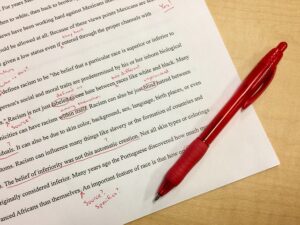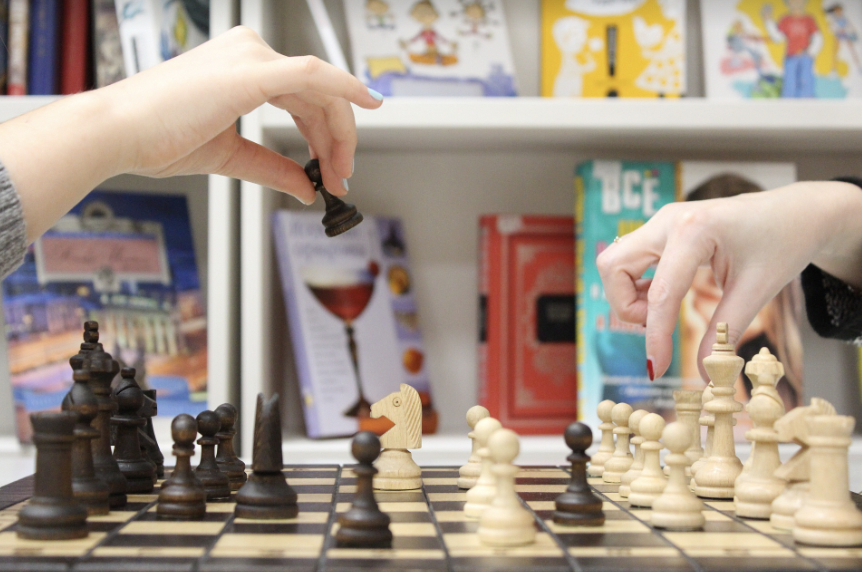5 min read
Share this post

In this post I want to talk about a polarizing topic: how to correct ESL students’ mistakes. It’s polarizing because there are strong and conflicting opinions on the subject and it’s not easy to say that one approach is right and another is wrong. However, as a teacher, it’s your job to do it! In my years of teaching, here are 4 tips I’ve learned.
.
.
.
First, let’s talk about class size. My general rule here is the larger the class, the more delicate I try to be with corrections. With one-on-one students, anything goes: you ask the student how they’d like to be corrected, and you follow that. Since a one-on-one student doesn’t have any peers to be embarrassed in front of, they’ll often have no problem with asking to be interrupted. Even if you’re shy about doing this, don’t be — instant feedback is the fastest way to learn just about anything! Groups are a different ballgame, however. Whether it’s competing students or superiors in class with subordinates at companies, there are a lot of moving parts and complicated power and ego structures to consider. In a perfect world, none of that would matter, but in general, the larger the class, the more carefully you should correct!
.

If your classroom is a lecture hall, be careful with corrections!
.
Next, let’s get into demographics. This is a fancy way of saying that you should take your students’ culture, age, and other factors into consideration when deciding when and how to correct. Children may be apt to tease each other for an embarrassing mistake, and in some cultures a correction that’s too abrupt may come across as embarrassing or even offensive. In other cultures, if you don’t correct often or forcefully enough, your students may begin to question your expertise. When in doubt, ask an experienced teacher of the same demographics for some pointers about what works and what doesn’t.
.
.
Third, let’s talk about positivity! While it goes without saying that you should never laugh at a student’s answer, I’ve found it best to avoid any negativity at all. If a student says something that’s incorrect, I don’t say “no,” or “that’s wrong,” or even “not exactly.” I’m careful not to scrunch up my face or shake my head. Instead, I simply say the correct form. If a student says “I’m feel good,” I say “I feel good” with a nod and a smile. It’s amazing how much of a difference in confidence your facial expressions and demeanor can cause.
.

Positive correction: it’s an art form!
.
Finally, an important point about when to correct. If I’m working with some pre-intermediate students, and one of them butchers an attempt at a mixed conditional, I beam with pride that they even tried. I compliment them for attempting such an advanced tense. No, this is not a situation where everyone gets a trophy just for participating, but an acknowledgement that sustained effort in any endeavor requires encouragement. If your students should already know the past simple, for example, then feel free to correct it any time it comes up. However, tread carefully when they make mistakes on things they haven’t learned yet!
.

The dreaded red pen!
.
.
As teachers, it’s our job to correct ESL students’ mistakes. It’s just not easy! Do you have a creative way to correct students that works for you? Maybe something outside the box? Please share it in a comment so that everyone can benefit!
Share this post



31 Comments
Hi Chris,
I no longer work with children – except with one Japanese American, but that’s another story! My students are adults.
During the Trial Class, I sort of lay down the rules. I warn them that during any form of conversation, I WILL interrupt and correct them immediately and not leave it until the end of the class. I have never had anyone who has not accepted that; indeed most say “that is what I want” and so I oblige. I do joke about it e.g. “after several classes you will be throwing books at your webcam when I interrupt but it’s OK – I am several hundred miles away!!”
When it comes to Reading errors in text or written homework, it is normally a matter of incorrect reading and my standard comment is “read what you see – not what you THINK you see” which normally works.
Correction of Writing and Grammar is a little more and I think it is down to the individual coach and student as to what way they wish to handle it. But the correction should take place immediately at the time it occurs and not put off until the end of a session.
Just my pennyworth!!
Thanks for your comments, John, and as a fellow one-to-one teacher, I do the same!
Agreed!
Hello. Have you heard of CELTA? I believe you have. If you haven’t, let me fill you in: CELTA is an international certificate to teach English anywhere in the world.
Well, they claim that correcting students right after they make a mistake, is not the correct approach. Students might be reluctant to open their mouths in the future because they might feel insecure.
With your next student, try this approach. Maybe, it’ll bring you better results. I mean, students might feel more confident.
John, Your idea about interruptions and how to make the “rule” less formal is great. I also love the statement, “read what you see – not what you THINK you see”. I have a lot of students who see similar letters of another word and ‘read’ the word they know, not the word in the text.
I’ve used all the ideas of correcting in the posts and I think all of the strategies can be right, for each particular student. I teach ELL students and corrections often depend on the student’s level in his or her language skills.
First of all thanks for sharing your thoughts which are helpful. In my view, I think that when we, teachers, correct students’ mistakes we have to do it in a positive way so they will feel confident that they can speak and be understood without hesitation.
I’ve enjoyed reading all of these replies to the excellent article. I teach adults and want everyone to be comfortable, so I make correction a class norm. I announce the first day, or whenever we get a new student, that I will correct their English, that I’m not picking on them:), and that I will at times use their mistakes as a teachable moment. Everyone agrees heartily because they know they make mistakes and they are there to improve.
I learned a good deal about how to do this better from Chris and the rest of the teachers.
Many thanks,
Michele
Thanks so much for this reply! It sounds like your students are lucky to have you as a teacher.
Excellent post.
What about peer correction or self-correction? I use a simplified rubric to correct writing. They can exchange pieces of writing and attempt to correct peer mistakes using this rubric.
Hi Marcela, definitely, peer correction and self correction are certainly helpful!
Great tips
Thanks Aimee!
I have been teaching for 30 years and i am sure students need and want to be corrected it s just how teachers do it. When correcting the student refer to the whole class as it may be useful for everybody. Don t make the student feel embarassed or worse stupid. If the student has difficulties to understand the correction avoid insisting as this could create frustration. Let them know you are willing to offer them individual and personal support. Smile, Do not take corrections too seriously as nobody is perfect.
Great tips Patricia, thanks for sharing!
I tend to let the student finish, then repeat back what they said and ask if they can identify their own mistake. I don’t know if it’s efficient but it works for me.
Yes, self-correction is ideal — it’s one step closer to not needing a correction at all! Anything you can do to foster self-correction is great!
Why don’t you pay attention to moms? Moms correct their kids all the time and do not cause them any harm. Why not? Because they do not make it a big deal. Watch “pursuit for Happiness” with Will Smith and listen to him correct his kid when he says,”I’m a children.” Will say, You’re a child, without ren.” Bam! That’s it.
I try to do the same thing. I try to make my students comfortable with their mistakes , and sometimes, even laugh at them. Why not?
I recall a teacher who used to put his left hand on his heart pretending to be having a heart attack everytime one of us made a mistake. We thought it was funny. I don’t do that, though.
Keep it simple, like moms.
Very interesting take — I think the reason parents can correct without harm is because the children know they are in a safe environment with their parents. If we as teachers can create an environment where our students feel safe, then we’re doing a great job!
A great topic, and one that should be discussed regularly. I have developed strict personal methods of classroom correction which have served me well, and they depend very much on the stage of the lesson.
During the presentation stage it’s important to correct every error, model the correct language and ask the learner to repeat it a couple of times. I often drill the whole class then go back to the individual. That way they’re all in the same boat and the learner knows it’s okay to struggle a little at the beginning.
During controlled practice you can’t tell whether an error is just a slip of the tongue or an incomplete understanding of the language point, so concept-checking is the key. The activity won’t flow as a natural conversation yet, so I interrupt the activity to ask the group/class questions to check their understanding and prompt them to correct themselves/each other.
If errors are made during class discussions or group free practise exercises, the way I deal with it depends on the error. If it’s an error in the target language, I pop in, do a quick correction and pop out again. Rather than feed them the correct version, I’ll repeat their error use questioning intonation and hand gestures to highlight where the error was and allow them to correct it themselves. It’s important that the learner has had plenty of controlled practice before I use this technique: the last thing I want is to derail a group activity to re-teach the language point!
I record any other errors that occur during the activity to do a quick remedial session to round it up. The student who made the error knows who they are, but none of the others needs to know who said it.
Finally, we all have that one learner who constantly forgets to put verbs in the past, or uses “what” instead of “that”. These are bad habits and need to be handled as such, so I have a quick one-to-one with the learner first to get her approval, then I use a Pavlovian form of correction where each time the error occurs I just interject with one word (e.g. “flew” or “that”) so that it doesn’t disturb the flow of the conversation. Over time the error disappears. This is particularly useful when I’m teaching online, either a group or one-to-one.
Every teacher needs to find the combination of methods and body language that suits them best, but as Chris wisely points out, the most important task is to provide a safe, nurturing environment so that correction is taken as support not criticism.
Sue, thanks so much for sharing these excellent and concrete examples. I can use just about all of this!
we all have very different personalities and we are not all able to cope with corrections. first build trust and then choose the right approach. kids accept our corrections because they trust us but once they get into their teens it’s game over:)))
Building trust is key — no matter the age!
I try to repeat their incorrect structure correctly in my conversational reply when it is my turn to respond to their comment. ” I not do that.” . “Yes, Pepe, I don’t do that either.” If that is not appropriate, as I don’t want to disrupt their fluidity or train of thought, then I repeat their incorrect sentence at the end of the class and I ask them what they did wrong. In both cases, they usually groan and smile as they know immediately. I only teach one-to-one nowadays but would rarely use the second method in a full classroom situation. If we are focusing on a particular weakness over a few lessons, I will grunt loudly immediately and give them a look, every time they make that particular mistake, (I really don’t care if they lose their train of thought in that case as that is our grammar focus/bad habit for the week), and I live in hope that they self-correct that error or bad habit right away.
Great ideas, Angie, I use a form of the “grunt loudly immediately and give them a look” too!
I usually have one to one class. I TRY to use the word NO to reinforce an error. I correct with a lot of soft skills and when possible let the student correct themselves . I have the advantage of having all Spanish speaking students and communicate errors quite often with a Spanish explanation
If you can use L1 as a way to add more nuanced explanations, that’s fantastic!
extremely helpful. thanks a lot
You’re very welcome!
Hi Chris
Depending on my students, I use different ways. The best has been collecting several of the students mistakes, copy them on the board and asking all to correct them.
Good strategy!
Thanks Chris, great tips as usual!